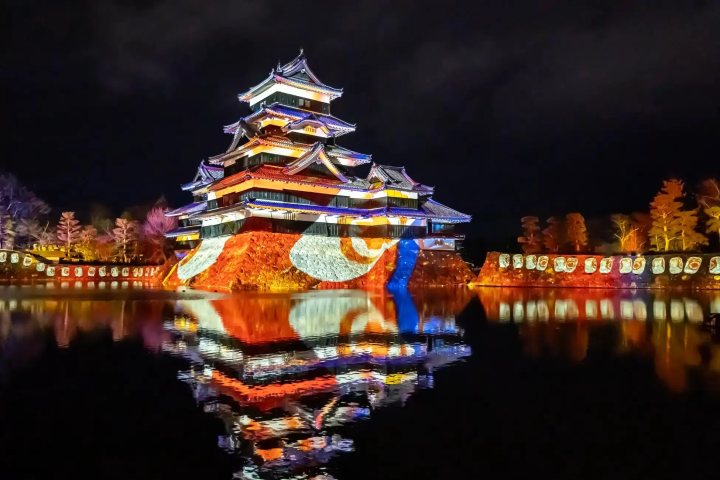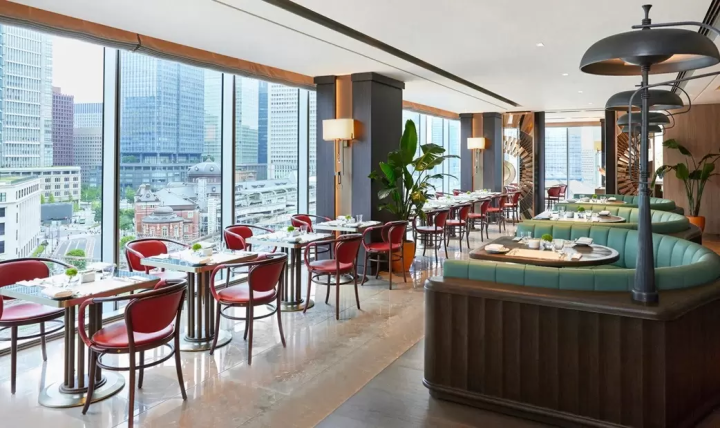Yakitori Grilled Chicken: A Guide to Restaurants and Yakitori Types

Yakitori, skewered, grilled chicken, is one of the most popular dishes in Japan. This article explains how to eat this delicious dish, what kinds there are, and recommended yakitori restaurants, from inexpensive chicken restaurants to Michelin star level places.
Yakitori - Must-Try Japanese Grilled Chicken

Photo by Pixta
Yakitori is a Japanese dish where chicken meat is cut into small pieces, skewered on bamboo sticks and grilled. There are usually several pieces on each skewer (anywhere from one to five), which are seasoned and cooked on an open-fire grill. It is a favorite dish of many, and a must-try when in Japan.
Continue reading to learn about how to eat yakitori properly, recommended yakitori restaurants, and about different varieties you'll find throughout Japan.
Table of Contents:
1. How to Eat Yakitori
2. Where to Eat Yakitori
3. Yakitori Chain Restaurants
4. Famous Yakitori Restaurants
5.Yakitori Prices
6.Ingredients and Varieties
7.Regional Yakitori
8.Calories in Yakitori
The Best Way to Eat Yakitori
1. Eat the Lightly Seasoned Dishes First

Photo by Pixta
In order to eat yakitori in the most delicious way possible, you should start with the lightly seasoned varieties first. For example, start with sasami (chicken tenderloin), a refreshing cut of meat, then move on to the heart, otafuku and other dishes, slowly increasing the depth of flavor at a time. There are no rules, however--you can also just eat whichever types you like, in whatever order you like.
2. Bite into the Meat on the Skewer
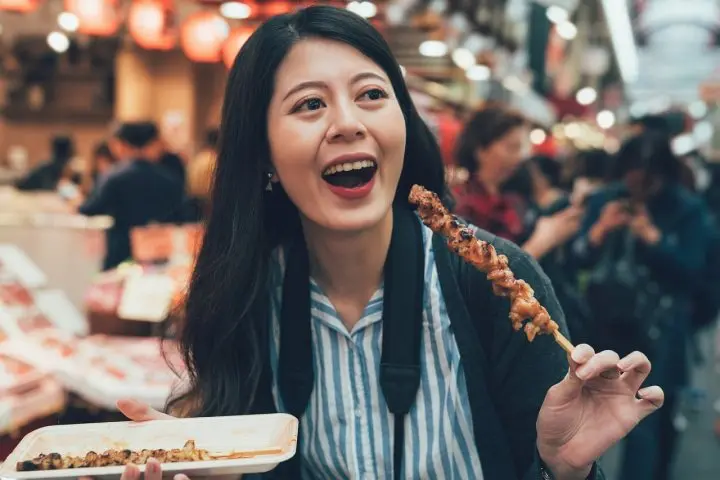
Photo by Pixta
It is said that the most delicious way to eat yakitori is to eat it while it is on the skewer. The workers toil endlessly away every day to put just the right amount of meat and seasoning on each and every skewer, and it is believed by many that this effort makes the yakitori itself taste even better, hence eating it on the skewer is best.
There is a container placed on every table where you can put your used skewers after eating the yakitori. If you aren't sure which is the skewer container, ask the staff to point it out to you.
Manners When Eating Yakitori

Photo by Pixta
There are also other seasonings available for your yakitori; cayenne pepper, shichimi togarashi (seven spices blend), sansho (powdered Japanese pepper), wasabi, black pepper and other condiments are usually on the table already.
But we would like to point out that it is not recommended to put shichimi, sansho or other flavorings on just cooked yakitori. For the chefs, the yakitori is at its best when freshly made. To not offend the chef, try a bite-sized portion of the yakitori without extra flavoring first; you can always add some to the meat afterward.
Where to Eat Yakitori

Yakitori can be easily enjoyed all across Japan. Specialty shops, izakayas, festival food stands, chain restaurants are common places where yakitori is on the menu. You enjoy fresh grilled chicken anywhere.
Many supermarkets are even sell yakitori in the deli sections, too. Simply heat these pre-cooked skewers in the microwave and you will have easy yakitori. Some grocery stores and convenience stores also sell frozen or packaged yakitori.
Yakitori Chain Restaurants
Tori Tetsu
Tori Tetsu is a popular chain of yakitori restaurants with 62 locations spanning across Japan from the Tohoku region to Kyushu. One skewer here costs between 130 to 300 yen. Other than yakitori, they have chicken sashimi, gyoza dumplings with chicken, soba noodle dishes and various other delights. A great izakaya-like place for young people, Tori Tetsu is also popular with families, making this an all-around popular chain shop.
Torikizoku
When saying 'yakitori' many Japanese people immediately think of Torikizoku; it is that popular of a chain shop. Found throughout Osaka, Tokyo, and Nagoya, one of the greatest appeals of Torikizoku is its price. Everything in the restaurant costs 280 yen (before tax). Two sticks of yakitori are 280 yen, drinks (including alcohol), even ramen cost 280 yen.
Toridori
Toridori is a chain of yakitori shops that originated in Tokyo. Their unique feature is that they use Tsukuba tori and Koshi no tori types of chicken in their yakitori. The interior of their shops is so trendy and clean that you would never imagine that they could be a chain or izakaya. If you would like to feel a truly Japanese atmosphere while enjoying yakitori, this is our recommendation.
Ore no Yakitori
Ore no Yakitori is part of the Ore no French and Ore no Italian family of restaurants. There are a few locations in Tokyo. Other than serving yakitori, they also have roast beef and sushi on their menu. At their Ginza location, you can listen to live jazz music performances as you enjoy your yakitori.
Yakitori Dojo
Yakitori Dojo is a yakitori chain that is found all over Japan, from Hokkaido to Kyushu and is most well-known for their chicken and vegetable-rich chiritori hot pot, which has a slightly spicy miso soup base. Eating a rich hot pot alongside yakitori sounds good, doesn't it?
Yakitori Daikichi
Yakitori Daikichi is a chain that have expanded not only through Japan but overseas. Served carefully by the skewer, the yakitori in this shop is cooked right before the customer's eyes. Other than the standard types of yakitori, they also serve many unique dishes, like chicken cheese yakitori and chicken wrapped in shiso (perilla) leaf yakitori.
Well-known Yakitori Restaurants
Bird Land Ginza
Bird Land Ginza received a 1 star rating from the Michelin guide (in 2015), granting it not only nationwide but international recognition and approval as a gourmet yakitori restaurant. The menu features two set courses ideal for an elegant dinner. Now there are more shops offering wines paired with their yakitori, but Bird Land was the pioneer of this style of establishment.
Torikou
Torikou uses a high grade of charcoal known as binchotan, which is made from the ubame oak, to grill its yakitori. The chefs in this restaurant carefully prepare each skewer one at a time, ensuring that each skewer is at its most flavorful when served. When visiting Torikou our most recommended dish is their tsukune, which is the dish that they are the most fastidious about.
Inakaya East
The robatayaki (food prepared before the customer's eyes) restaurant, Inakaya Higashi is exceptionally popular with travelers from overseas. Inakaya has two locations in Roppongi, in the east and west of the station, and one location in New York.
Since its establishment, the President of the United States, various leaders from countries around the world and celebrities have visited this restaurant. It has become a very highly regarded restaurant abroad. The dishes, including fish and vegetable ones, are all prepared before the customer's eyes on an irori, a traditional Japanese earthen grill and served on a wooden shamoji (rice scooping spoon) about the size of a kayak paddle to the waiting customers.
Gonpachi
Those wanting to enjoy the genuine taste of Japanese food surrounded by an atmosphere that evokes images of brave samurai should by all means visit the Japanese restaurant Gonpachi G-Zone Ginza. Here yakitori can be order directly from the showcase, where it will then be charcoal-grilled to perfection as the delicious aroma of the meat tantalizes your appetite in front of you.
Sumibi Yakitori Omoya Ikebukuro
Sumibi Yakitori Omoya Ikebukuro shop is another restaurant with many Japanese fans. The modest interior and simple but delicious dishes served here are reminiscent of the izakaya in Japan of days gone by, which makes this the perfect place for those who would like to experience life in the Japan of the past.
Torisho
Amid the rapidly changing landscape of Akihabara in a valley formed between the grand buildings stands Torisho, a yakitori restaurant of long-standing that was established in 1980. The appearance of this shop is so impactful that you are sure to forget that you are even in Akihabara. With a wide selection of delicious sake to choose from, this is a very popular restaurant.
Omoide Yokocho - Shinjuku Station's West Exit
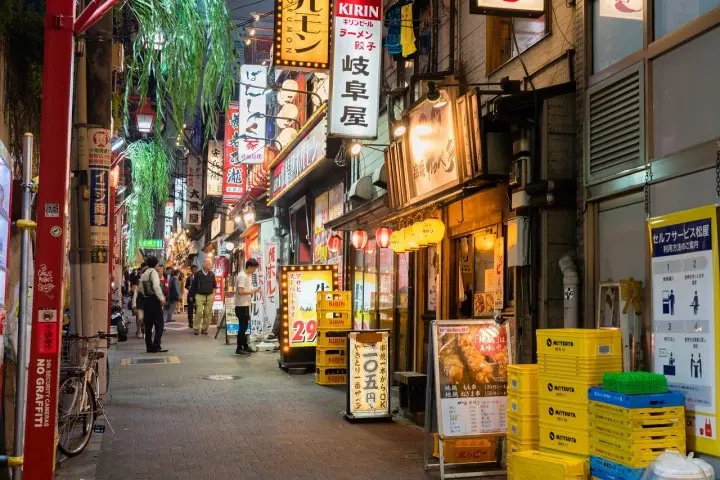
Photo by Pixta
A 5-minute walk from Shinjuku Station's west exit, here you will find plenty of businessmen with their ties loosened stopping by for a short break before heading home from work. This famous place is Shinjuku Station's West Exit Omoide Yokocho, where the moment you step into the area you are sure to hear the sounds of people drinking, eating and having a great time with one another.
Omoide Yokocho is a collection of about 70 tiny, food stall-like restaurants, of which 17 are yakitori places. The juicy scent of yakitori actually drifts down this long and narrow street. Even first-time visitors here are greeted with a warm and genial welcome and made to feel right at home; this is a perfect place to alleviate any stress.
Regional Yakitori
Hokkaido's Bibai Yakitori

Photo by Pixta
The most distinctive feature of Bibai Yakitori is that a single skewer comes with many different types of meat and vegetables on it. Boiled chicken meat and offal and onion skewered together and seasoned with salt and pepper before being grilled. Called motsugushi, this Bibai specialty is eaten at parties and even for important family occasions.
Muroran
Muroran is not actually a yakitori place - it serves all roast pork skewers instead. Pork loin and onion are grilled together over a charcoal fire, seasoned with a sweet tare sauce and served with Japanese mustard. And, though green onions are standard ingredients in most yakitori shops, as access to Hokkaido is sometimes limited due to snow in the winter, regular onions, which have a much longer shelf life than green onions, are used in these dishes. The combination of onions and pork is perfect.
Fukushima City, Fukushima Prefecture
Fukushima yakitori is said to be the most orthodox type of yakitori, and is practically identical to that eaten in the Kanto region. Everything from the raw ingredients to the grilling techniques are particularly focused on, with both the chicken and the pork selected being only the best of the best. Here chicken and pork are referred to as 'yakitori' as well.
Higashi Matsuyama, Saitama Prefecture
One of the most distinctive traits of Higashi Matsuyama yakitori is its use of pork cheek and 'kashira' meat skewers that are well-seasoned with a spicy miso tare. Other popular types of this spicy yakitori are tongue and liver, nankotsu and other volume-packed skewers. If it doesn't have spicy miso tare on it, it's not Higashi Matsuyama yakitori!
Imabari, Ehime Prefecture
Imabari yakitori isn't grilled on a skewer over charcoal but made on an iron plate. What makes this style so special is its speed. As the chicken is cooking on the iron plate, the oils come out and start to fry, to this then a technique known as pressing is added, which steams the meat, and overall cooks this dish in a surprisingly short time. One of the final foods you should eat when visiting these restaurants is the 'senzanki', a special type of fried chicken.
Nagato, Yamaguchi Prefecture
Said to have been influenced by Hakata yakitori, Nagato yakitori features a mixture of chicken, pork, and beef on a skewer which is cooked then seasoned with a liberal dressing of garlic powder before eating. This style is also known for using onions rather than green onions as well. And, though yakitori restaurants are often staffed by men, the Nagato city yakitori shops tend to be run by women instead.
Kurume, Fukuoka Prefecture
If it's skewered, it is yakitori - that is the thinking behind Kurume yakitori. One of its features is that these skewers are often wrapped in seaweed. At Yakitori Teppou in Kurume city, their 'asparagus niku maki' (meat-wrapped asparagus) was one of the first types of 'produced yakitori', a fact that soon lead to a boom in the city of other types of specialty skewers. Furthermore, Kurume city is well-known for its horse meat cuisine, so in the past, you could also enjoy fresh horse offal yakitori as well.
The Differences Between Types of Yakitori
Depending on the menu of the shop, the parts of the chicken used in yakitori may have different names. As each part has its own prices, seasonings, and food texture, it is a good idea to have an idea of what to expect before heading to the restaurant. Despite using the same parts, each restaurant may have its own shop-based name for certain types of yakitori, so please be careful when ordering.
Ha-tsu
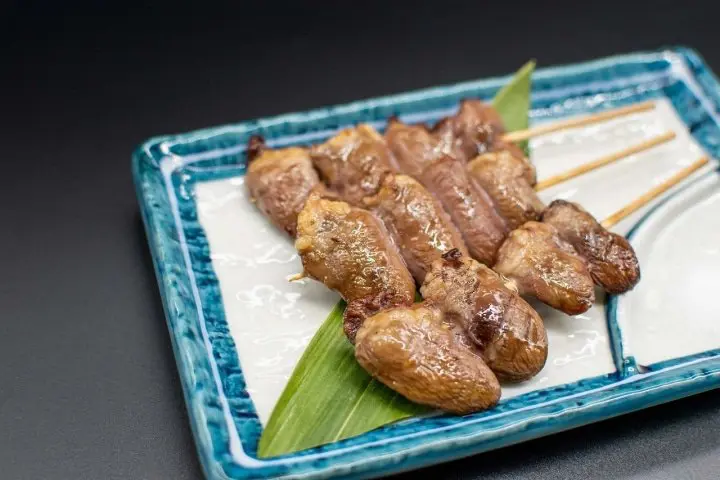
Photo by Pixta
'Ha-tsu' are chicken hearts and, of course, only one can be taken from each bird. They have a strong consistency to them when being chewed and taste faintly of iron when eaten. In the photo, this type of yakitori is referred to as 'Maru Heart'; the inner membrane of the heart has been turned inside out, creating a cone-like shape. This type of yakitori has more oil to it and is more tender than standard hearts.
Seseri
'Seseri', in Japanese, means chicken neck meat. As this is also fairly well-muscled meat, it has a strong consistency to it like the heart and a deeply condensed, rich flavor.
Sunagimo
'Sunagimo' is chicken gizzard, a part of the bird's digestive system. This meat has a characteristic springiness to it, and a firm food texture when eaten. As it is a somewhat dry cut without a strong base to it, the gizzard is best enjoyed with a simple seasoning. Rather than adding tare to it, most would agree that salt is the best match for gizzard.
Tsukune
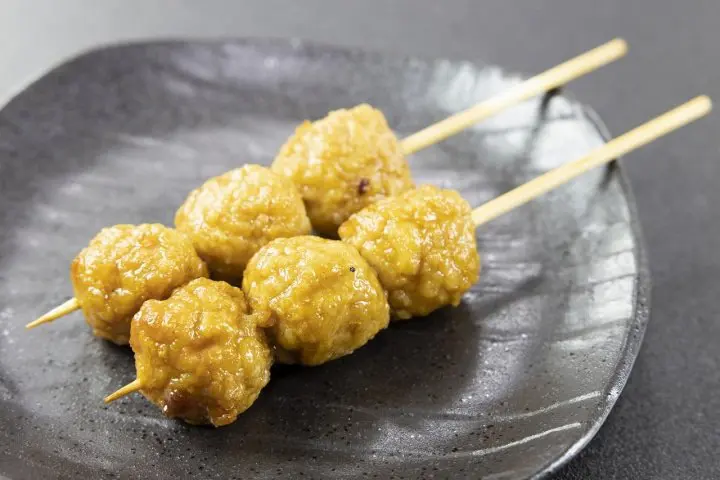
Photo by Pixta
'Tsukune' is made from minced meat that has been formed around the skewer and then cooked; it is a more labor-intensive form of yakitori. Tsukune typically comes in small meatball-sized or cylindrical portions. The ingredients, seasonings, and styles of tsukune vary quite widely by restaurant, so it is best to head to a shop and try it for yourself.
Sori Re-su
'Sori re-su' is the Japanese translation of a French expression meaning "only a fool leaves this behind"; it is the exterior cob portion of a chicken thigh. This is the hardest working part of a chicken, and as such the meat has an incredible elasticity and savory taste to it. It goes without saying that only two of these valuable cuts can be taken from a single bird.
Kokoro Nokori
'Kokoro nokori' refers to the root that connects the heart to the liver. The term itself, when translated means "(the) heart's leftovers", as it is seen as an extra piece of meat from the heart. As this cut tends to have more fat to it, it is best eaten with salt rather than tare. Depending on the restaurant, it may be called 'kan', 'tsunagi', 'akahimo' or other terms.
Negima

Photo by Pixta
'Negima' may be the type of yakitori most likely to be pictured by people when thinking of this dish. In between pieces of chicken, chunks of negi or green onion, are place and the skewer is then grilled - it is a great match to the chicken and a standard of all yakitori shops.
Kawa (Skin)

Photo by Pixta
'Kawa', or chicken skin is the only part of the chicken where you can enjoy not only a springy texture and the fatty richness of chicken meat at the same time. Depending on the shop, some may serve this part while still attached to the chicken neck. In the photo above, this is the neck and skin grilled together on one skewer.
Nankotsu

Photo by Pixta
The 'nankotsu' or cartilage, especially that of the pointed end of the breastbone, is a comparatively soft part of the chicken. Rather than having a distinctive flavor though, the most characteristic feature of nankotsu is its crunchy texture. As the lowest calorie part of chicken, nankotsu yakitori is the best type for those on diets to enjoy.
Liver

Photo by Pixta
'Rebaa' is the Japanese phonetic pronunciation of liver, meaning in this case chicken livers. Having a peculiarly soft yet viscous texture to it, this rich and glossy meat is still quite enjoyable. Although many people are not fond of eating liver, if you are at a yakitori restaurant, this is a dish that we recommend trying at least once.
The freshest and highest quality livers do not have the smell or same taste to them as standard ones, and the rich flavorful nature of the meat is sure to spread out across your palate. This type of yakitori is most commonly eaten with tare seasoning.
Furisode
'Furisode' is the term used to refer to the shoulder meat of the chicken, which is the intermediate portion of the chicken between the breast and the wing. Properly prepared, this cut has both the flavor of the skin and the richness of the meat, and is best eaten with pure soy sauce.
Bonjiri
'Bonjiri' is the term for the pope's nose, or the meat from the rear end of the chicken. The bottom of the chicken has a higher amount of fat than other parts, giving it a plump juiciness and truly enjoyable texture.
Otafuku
'Otafuku' refers to the flank portions of the neck meat which contain the esophagus and lymph nodes. The surface of this cut has a nice layer of viscous fat to it, while the inside is crunchy - giving it an overall enjoyable mouth feel and delicious taste.
Teba
'Teba' refer to the full wings of the chicken, while 'tebamoto' refers to the upper portion of the wing, and 'tebasaki' to the tip. Teba are known for having little fat in the meat. Freshly grilled chicken wings seasoned with salt have a great crunch to their surface while the meat inside is quite tender.
Ingredients Other than Chicken
Yakitori restaurants don't only sell chicken; at many you can also enjoy a variety of pork dishes. As this tends to be pork rib meat or organs, many areas refer to this dish as 'yakiton' (grilled pork), but there are also many places that, regardless of what sort of meat it is, refer to foods grilled on a skewer as yakitori.
Recently, many unusual varieties of this dish have come on the market, such as ones paired with ketchup, cheese, kimchi and other ingredients. While not available at every yakitori restaurant, if you happen to find some of these unique types of yakitori, please give them a try.
Buta bara
'Buta bara' is the term for pork ribs, specifically the meat around them, which is best known for its high fat content. Although not a standard menu item at every yakitori shop, it is quite popular in the Fukuoka and surrounding area. If you search for it though, you are likely to find it somewhere in Tokyo. If so, please give it a try.
Tonsoku
'Tonsoku' are pig's feet. While there is little meat to this part, there is plenty of skin, suji (tendon) and cartilage. It is best known for being a collagen-rich dish. While it is commonly boiled or simmered in other dishes, in Fukuoka grilled pigs' feet are often found at yakitori shops.
Kashira
'Kashira' is the temple portion of a pig's forehead. While it is a well-muscled portion and has little fat to it, this meat is very flavorful and has a characteristic, somewhat hard texture to it.
Tan (Pig Tongue)
'Tan' is the tongue of the pig. Compared to that of beef, tan is tougher and has less fat to it. Although the texture is nearly identical to that of beef tongue, it is quite popular for its low price and richness of flavor.
Gatsu
'Gatsu' is the phonetic pronunciation of 'guts', as in pork stomach. It has little fat, no off-putting flavors or aromas and is an overall easy to eat type of meat. While a little firm, it has a feeling similar to chicken gizzard when eaten, which makes it very distinct.
Shiro
'Shiro' refers to the large intestine of pork. It has a very chewy and springy texture; as a moderately fat type of meat, this type of yakiton gains in flavor the more you chew it.
Teppou
'Teppou' is the term for pork rectum. When open, it is said to resemble a teppou, the wooden pole that sumo wrestlers strike during practice, which is where the name comes from. With a powerful elasticity and chewy texture, it is at its most delicious when cooked almost to the point of burning.
Kobukuro
'Kobukuro' is pork uterus, which is known for its refreshing and crunchy texture when eaten. It doesn't have the aftertaste that some offal does, making it an easy to eat type of yakiton.
Beef and Horse
Among the many different yakitori shops in Japan, there are also some that serve beef and horse meat dishes. However, compared to chicken and pork skewers, beef and horse meat dishes are relatively expensive. If you happen to find yourself at an establishment offering these dishes, please give them a try.
Uzura no Tamago
'Uzura no tamago' or quail eggs, are first boiled, seasoned with a soy sauce based tare, then skewered and grilled on an open flame the same way that standard yakitori are prepared.Hot, freshly made uzura no tamago are an excellent match with alcohol. There are some establishments where you can eat the egg cooked in its shell, which have become popular as well.
Grilled Tomato and Other Vegetables
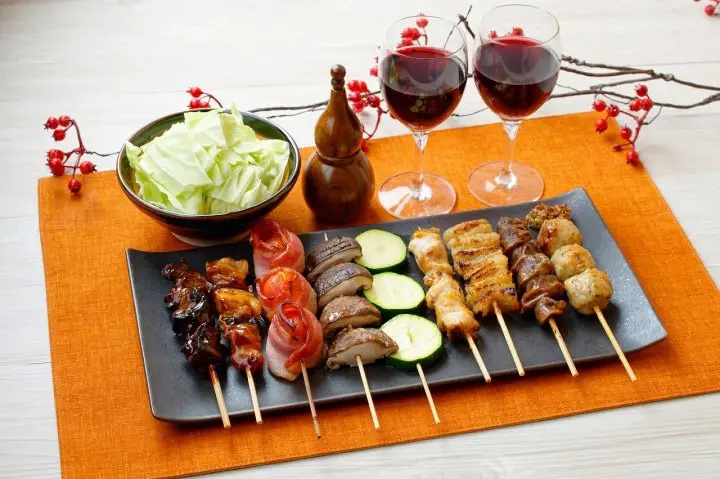
Photo by Pixta
It is also possible to find tomatoes, onions, shiitake mushrooms and other vegetables and mushrooms skewered and grilled without seasoning; in these types of yakitori, you can really enjoy tasting the original flavor of the vegetables.
Bacon-wrapped Asparagus

Photo by Pixta
Although you can find unseasoned asparagus skewers, bacon-wrapped asparagus or pork rib and asparagus skewers are two standards in many shops. Asparagus softened by the juices from bacon or pork ribs are very delicious.
The majority of yakitori restaurants also have menus featuring salads and alcohol; as previously mentioned, yakitori is not only available at specialty shops, it may also be found in izakaya, or Japanese-style pubs. Yakitori is an excellent match with many different types of alcohol, so by all means, please enjoy some sake with your yakitori!
Calorie Counts in Yakitori
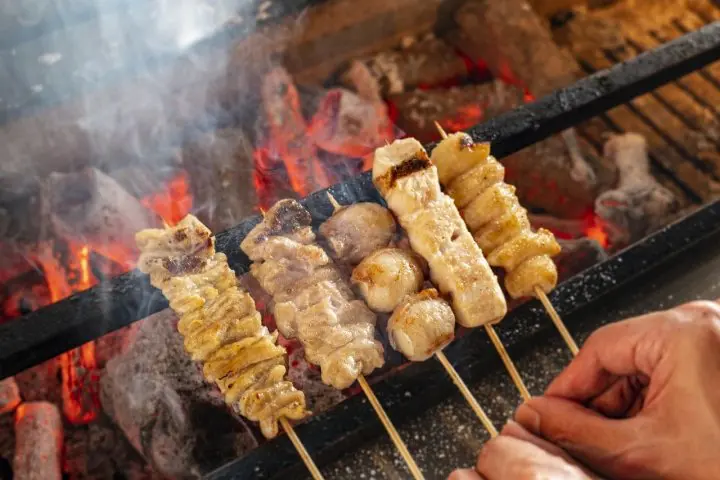
Photo by Pixta
As most yakitori is made from chicken, it is considered to be a comparatively healthy dining option. And with plenty of protein in it, it is also the perfect food for dieters. So for those on a diet that find themselves craving meat, this is the best option for you.
Although it varies by part of the chicken, one skewer on average is roughly 75 kcal, and skewers seasoned with salt rather than tare are slightly healthier still, losing about 8 to 10 kcal. Bonjiri, kawa and teba, 3 of the most popular types, come in at about 100 kcal per skewer. On the other hand, 50 kcal and lower types of yakitori are liver, nankotsu and sunagimo. Parts with plenty of fat to them are considerably higher in calories, of course.
Yakitori Prices

Photo by Pixta
Yakitori also has a wide range of prices, which change vastly from shop to shop. A single skewer at a chain restaurant costs about 120 to 150 yen, which is a reasonable price for some pretty delicious dishes. On the other hand, yakitori sold in popular high-class specialty shops cost about 300 yen per skewer.
And, for restaurants offering yakitori, meals with alcohol alongside several plates of these chicken dishes will cost about 2000 to 5000 yen per person, while more elegant restaurant courses will cost about 10,000 yen per person.
Yakitori is the perfect restaurant choice when you want to eat something fun or if you are going out for a special evening. When you are heading out to a yakitori place, check the prices on the menu board before you venture into the shop so that you will know what you're getting into price-wise.
Have a Great Time Enjoying Yakitori in Japan
Yakitori, a chicken lover's dream dish, is available in moderate to extravagantly priced shops and in countless varieties. Go out and find the perfect skewer to suit you.
Read also
Main image by Pixta
旅行が趣味の22歳です。日本の魅力をお届けします。




























